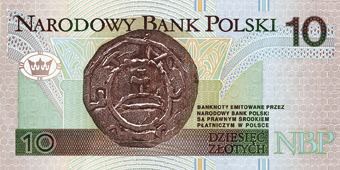Height 60 mm | Width 120 mm Paper type White Paper | |
 | ||
Security features Watermark, a security thread, microprinting, ultraviolet ink, a see-through register (recto-verso), latent image (angle effect), metallised ink. Years of printing 1794–1831; 1924–1950; 1950–1995; 1995–present | ||
The 10 Polish Złotych note is the lowest value złoty banknote and has been used since the redenomination of the złoty in 1995. The note is used as the sole currency in Poland, a country with a population of about 38 million.
Contents
It is the smallest note, measuring 120×60mm with a dark brown and green colour scheme. The ten złotych note features a portrait of Duke Mieszko I in the obverse centre area, while the reverse depicts a denar, a silver coin from Mieszko I's reign. The banknote is protected with multiple security features, like watermarks and microprinting, which document its authenticity.
The ten złotych note has been used since 1794, along with the rest of the first złoty banknotes, although there were some temporary discontinuations in its usage.
First złoty banknotes
In 1794, treasury notes were issued in denominations of 5 and 10 groszy, 1, 4, 5, 10, 25, 50, 100, 500 and 1000 złotych. The Duchy of Warsaw issued notes for 1, 2 and 5 talarów.
In 1824, the Bank Kassowy Królestwa Polskiego issued notes for 10, 50 and 100 złotych. The Bank Polski issued notes dated 1830 and 1831 in denominations of 1, 5, 50 and 100 złotych, whilst assignats for 200 and 500 złotych were issued during the insurrection of 1831. From 1841, the Bank Polski issued notes denominated in rubel.
Second złoty banknotes
In 1924, along with provisional notes (overprints on old, bisected notes) for 1 and 5 groszy, the Ministry of Finance issued notes for 10, 20 and 50 groszy, whilst the Bank Polski introduced 1, 2, 5, 10, 20, 50, 100, 500 and 1000 złotych. From 1925, the Ministry of Finance issued 2 and 5 złotych notes, before they were replaced by silver coins, and the Bank Polski issued 5, 10, 20 and 50 złotych notes, with 100 złotych only reintroduced in 1932. In 1936, the Bank Polski issued 2 złote notes, followed in 1938 by Ministry of Finance notes for 1 złoty.
In 1939, the General Government overprinted 100 złotych notes for use before, in 1940, the Bank Emisyjny w Polsce was set up and issued notes for 1, 2, 5, 10, 20, 50, 100 and 500 złotych. After liberation, notes (dated 1944) were introduced by the Narodowy Bank Polski for 50 grosz, 1, 2, 5, 10, 20, 50, 100 and 500 złotych, with 1000 złotych notes added in 1945.
Third złoty banknotes
In 1950, new notes, which were dated 1948, were introduced for 2, 5, 10, 20, 50, 100 and 500 złotych, but 1000 złotych notes were added in 1962. 200 and 2000 złotych notes were added in 1976 and 1977, followed by 5000 złotych notes in 1982. The late 1980s and early 1990s saw high inflation in Poland and led to the introduction of notes in denominations of 10,000 in 1987, 20,000 in 1989, 50,000 in 1989, 100,000 in 1990, 200,000 in 1989, 500,000 in 1990, 1,000,000 in 1991 and 2,000,000 złotych in 1992. These notes (and coins) were valid, but with the exception of the 200,000 złotych note, until the end of 1996. They could be exchanged at the National Bank of Poland and some banks obligated to it by the NBP until 31 December 2010, and they are no longer legal tender.
Current banknotes
In 1995, notes, which were dated 1994, were introduced in denominations of 10 złotych, 20 złotych, 50 złotych, 100 złotych and 200 złotych.
